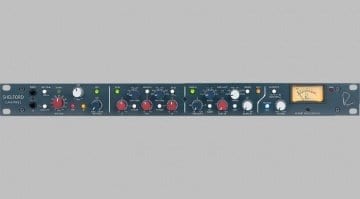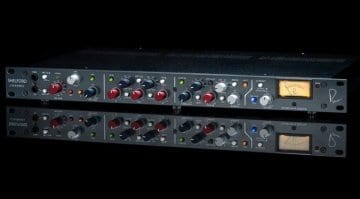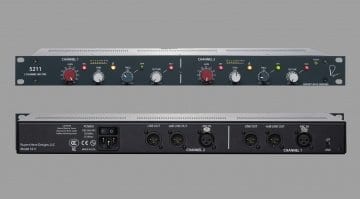Rupert Neve Designs Shelford Channel Strip: the best of Rupert Neve?
Ready for some proper high-end pro audio news? Reseller Sonic Circus announced the availability of the Rupert Neve Designs Shelford Channel Strip. This is a mono unit which combines a mic preamp, three-band EQ, compressor, and stereo-linked sends & returns. There’s a lot to cover in this prized unit, so let’s dig in!
Neo-Vintage
Best described as a neo-vintage module, the 1U rack unit is descended from Rupert Neve’s coveted 1073, 1064, 1081 and 2254 modules. It is, however, built around a new transformer-gain, class A mic preamp — Rupert’s first in over 40 years. The preamp is complemented by an inductor EQ section, diode bridge compressor, a saturation circuit, a dual-tap transformer output stage designed for optimum headroom, and doubled operating voltage. The Shelford combines the ‘essence’ of Rupert Neve designs from the past 50 years.
Input Stage & Mic Pre
The Shelford Channel preamp uses a direct-coupled custom transformer input. The RN4012 transformer provides the first 15dB of gain, and the rest of the 72dB gain comes from discrete Class-A amplifier blocks. Gain is controlled from a stepped attenuator and precision trim pot. The input transformer is directly coupled to the mic line.
Combined with Class-A input amplifiers, the RN4012 transformer achieves lower noise, improved isolation, and that revered Neve sound, of course. Additionally, the mic preamp has a sweepable 20-250Hz high-pass filter, Mic/Line input selection, 48V phantom power, and polarity inversion. A very capable unit, overall!
Dual-tap output transformer & Silk saturation circuit
The dual-tap output transformer (RN2042) offers high and low headroom outputs. The high headroom tap is made to capture more high end signal, avoiding non-linear coloration while taking advantage of the Shelford’s higher voltage.
The low headroom tap lets an engineer utilize the full voltage range of the channel without clipping audio interface inputs. The idea is to easily hit the transformer’s sweet spot for non-linear harmonic content, such as the sounds of drums, vocals, guitars, and other instruments.
Likewise, the variable Silk circuitry offers control over the output transformer’s harmonic content and saturation. By engaging it, harmonic content such as 2nd and 3rd order harmonics can be brought to several times beyond what’s available in older Neve designs like the 1073. There are Silk Red and Blue modes to emphasize either high (Red) or low (Blue) frequencies.
Direct Input
The Shelford’s Hi-Z front panel input uses the same class-A FET transformer topology as the Rupert Neve Designs RNDI. However, it takes advantage of the new RN4012 input transformer to bring more gain — improving clarity, adding low-end presence, and smoothing out high frequencies. The DI section also includes a passive THRU output for feeding a separate amplifier.
Classic Equalizer
The Shelford Channel has a 3-band, custom-tapped inductor EQ inspired by RND’s best vintage designs. The low frequency band is based on the 1064 circuit, which is known for its resonant bass. However, the LF band on the channel can be used as a shelf or peak filter for added punch, depth, and more control over the low end.
The mid-range band is based on the well-known 1073 EQ and is great for bringing instruments and vocals slightly forward in the mix. Furthermore, the mid frequency band’s proportional Q control makes it suitable for attenuating problematic frequencies.
Finally, the high frequency band is a hybrid design that uses capacitors for richer tone and improved control. It’s a modern piece of work which uses contemporary techniques and components to stop low-level artifacts and high-end harshness while minimizing feedback.
Diode Bridge Compressor
The compressor circuit is based on the same topologies found in vintage Rupert Neve designs like the 2254, but incorporates full-wave rectification and new control features. There are knobs and switches for timing, threshold, ratio, blend, make up gain, fast (attack-release modifier), HPF to Side Chain, Pre-EQ, Bypass, as well as Side Chain insert and Stereo Link.
Power Supply
The Shelford Channel has an internal auto-switching power supply with dual +/- 24V rails and standard IEC cable instead of the single 24V rail found in vintage Rupert Neve designs. The extra voltage improves dynamic range and noise performance.
Price and availability
The Shelford Channel strip is available now, priced USD 3495. More information can be found below.
 5,0 / 5,0 |
5,0 / 5,0 | 







